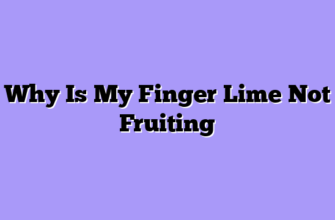There’s nothing quite as disheartening as watching your precious finger limes drop to the ground before they’re ready. I remember the first time it happened in my orchard – I’d been checking on my caviar lime trees daily, admiring the developing fruit, when suddenly I noticed the ground littered with tiny, immature limes. My heart sank. After all the effort I’d put into nurturing these Australian native citrus trees, why were they giving up on their fruit?
If you’re experiencing the same issue with your Citrus australasica (that’s the fancy scientific name for our beloved finger limes), you’re definitely not alone. This problem plagues growers from California to Florida, and I’ve spent countless hours troubleshooting it in my own groves. Let me share what I’ve learned through trial, error, and plenty of conversations with fellow farmers who grow these incredible “citrus caviar” trees.
Understanding the Delicate Nature of Australian Finger Limes
First, let’s talk about what makes these fruits so special – and so finicky. Finger limes, sometimes called lime caviar, citrus pearls, or simply bush limes by folks in their native Australia, aren’t your typical citrus. They evolved in the subtropical rainforests of Queensland and New South Wales, where conditions are quite specific. When we transplant them to our American orchards, we’re asking them to adapt to environments that might be dramatically different from their ancestral home.

The tricky part? There are at least a dozen different stressors that can trigger this response, and sometimes multiple factors work together to create the perfect storm of fruit drop.
The Most Common Culprits Behind Premature Fruit Drop
Water Stress: The Number One Offender
In my experience, improper watering causes more finger lime fruit drop than any other single factor. These trees need consistent moisture – and I mean consistent. Think of it like maintaining a friendship: you can’t ignore someone for weeks and then shower them with attention and expect everything to be fine. Your Citrus australasica feels the same way about water.
I learned this lesson the hard way during a particularly hot summer. I’d been watering my finger lime trees twice weekly, which seemed adequate. But when temperatures soared above 95°F for several days straight, I noticed fruit starting to drop. The issue? The soil was drying out between waterings, creating a cycle of feast and famine that stressed the trees.
Here’s what I’ve found works best: finger limes prefer soil that remains evenly moist but never waterlogged. I check the soil moisture about three inches deep – if it feels dry at that depth, it’s time to water. During peak summer, this might mean watering every two to three days. In cooler months, once or twice weekly suffices.
But overwatering is equally problematic. I’ve seen growers who water daily, thinking they’re being attentive, only to create root rot conditions that cause catastrophic fruit drop. The roots of caviar limes need oxygen, and constantly saturated soil suffocates them.
Nutritional Imbalances That Trigger Fruit Abortion
Let me paint you a picture from my own grove. Three years back, I had a block of finger lime trees that looked healthy – deep green foliage, good growth – but they kept dropping fruit at the size stage. I sent leaf samples to the lab, and guess what? They were severely deficient in potassium and magnesium.
Citrus pearls are heavy feeders, but they have specific nutritional needs that differ slightly from common citrus like oranges or lemons. I’ve created a fertilization schedule that’s worked wonders:
Essential Nutrients for Preventing Finger Lime Fruit Drop
| Nutrient | Role in Fruit Retention | Deficiency Symptoms |
|---|---|---|
| Nitrogen | Supports overall tree health and fruit development | Yellowing leaves, poor fruit set |
| Phosphorus | Critical for root development and fruit maturation | Stunted growth, fruit drop |
| Potassium | Regulates water uptake and fruit quality | Scorched leaf margins, premature fruit drop |
| Magnesium | Essential for chlorophyll production | Yellowing between leaf veins, weak fruit attachment |
| Calcium | Strengthens cell walls and fruit attachment | Blossom-end rot, easy fruit detachment |
| Zinc | Supports hormone production | Small, misshapen fruit, excessive drop |
I now apply a balanced citrus fertilizer with micronutrients every six to eight weeks during the growing season. But here’s a pro tip: slow-release formulations work better than quick-release options for bush limes. These trees evolved in forest soils where nutrients become available gradually, and they respond best to that pattern.
Temperature Fluctuations and Your Citrus Australasica
Finger limes are more cold-sensitive than many people realize. While mature trees can tolerate brief dips to around 28°F, the fruit is more vulnerable. I’ve noticed that even temperatures in the high 30s to low 40s can trigger fruit drop if they persist for several days, especially if the trees are carrying a heavy crop.
On the flip side, extreme heat above 100°F can also cause problems. During heat waves, I’ve observed that fruit drop increases significantly, particularly on trees in full sun exposure. The solution? I’ve installed shade cloth providing 30-40% shade over my most vulnerable trees, and it’s made a remarkable difference.
Pest Problems and Disease Issues That Cause Fruit Loss
Have you checked your trees for the Asian citrus psyllid? This tiny pest has become a major concern for all citrus growers, and finger limes are no exception. While they’re somewhat resistant to citrus greening disease (Huanglongbing), they’re not immune, and even stress from the psyllids themselves can trigger fruit drop.
I inspect my lime caviar trees weekly during the growing season, looking for:
- Sticky honeydew on leaves (indicates pest presence)
- Distorted new growth (a sign of psyllid feeding)
- Sooty mold (grows on honeydew)
- The psyllids themselves on new flush growth
- Signs of citrus leafminer damage
- Scale insects on branches and leaves
Last spring, I caught a citrus leafminer infestation early, and treating it prevented what could have been significant fruit drop. These pests stress trees by damaging the foliage needed for photosynthesis, and stressed trees can’t support their fruit load.
Root rot diseases, particularly Phytophthora, are another serious concern. I lost an entire row of finger limes before I understood the importance of well-draining soil. Now I plant on raised beds or berms, and I’ve had zero issues since making that change.
Practical Solutions That Actually Work
Let me break down my proven management strategy that’s reduced fruit drop in my orchard by roughly 70%:
My Seven-Step Approach to Preventing Fruit Drop:
- Maintain consistent soil moisture through drip irrigation on timers, delivering water slowly over longer periods rather than quick, heavy applications
- Apply balanced fertilizer specifically formulated for citrus every six to eight weeks during active growth, switching to a low-nitrogen formula before winter
- Monitor for pests weekly and address problems immediately with appropriate organic or conventional controls
- Provide adequate mulch (3-4 inches of organic material) around trees to moderate soil temperature and retain moisture
- Install windbreaks if your orchard experiences strong winds, which can physically knock off developing fruit
- Prune strategically to improve air circulation and light penetration without removing too much foliage
- Thin fruit manually if trees set more than they can realistically support – yes, this seems counterintuitive, but removing some fruit early ensures better retention of the remainder
Seasonal Care Calendar for Maximum Fruit Retention
| Season | Key Actions | Why It Matters |
|---|---|---|
| Spring | Increase watering frequency, apply balanced fertilizer, monitor for new pest emergence | Trees are actively growing and flowering; stress now affects fruit set |
| Summer | Deep water regularly, provide shade if needed, watch for heat stress | Peak fruit development period; water stress causes maximum drop |
| Fall | Reduce nitrogen, maintain watering, prepare for harvest | Fruit is sizing; trees are preparing for dormancy |
| Winter | Minimal fertilization, reduce watering frequency, protect from frost | Dormant period; overwatering or cold damage can cause spring problems |
Something I’ve noticed: the relationship between fruit drop and tree age matters significantly. Young trees (under three years) naturally drop more fruit as they establish their root systems. I actually remove most fruit from trees in their first two years, allowing them to focus energy on growth rather than production. It’s like asking a teenager to support a family – they’re just not ready yet.
When Fruit Drop Is Actually Normal
Here’s something that surprised me when I started growing caviar limes: some fruit drop is completely natural. These trees typically set way more fruit than they can possibly mature. It’s nature’s insurance policy – set lots of fruit, keep the best ones, drop the rest.
There’s a phenomenon called “June drop” (though it might happen in May or July depending on your location) where trees naturally shed excess fruit. I used to panic when this happened, but now I understand it’s normal. As long as you’re not losing more than 20-30% of developing fruit, you’re probably fine.
The key is recognizing the difference between normal physiological drop and stress-induced drop. Normal drop happens gradually over a few weeks. Stress-induced drop is sudden and dramatic – you’ll come out one morning to find the ground carpeted with fallen fruit.
Think of your finger lime tree like a student managing coursework. If they drop one class early in the semester to focus on the others, that’s smart planning. If they suddenly drop three classes mid-term because they’re overwhelmed, that’s a crisis requiring intervention.
Troubleshooting Persistent Problems
Sometimes, despite our best efforts, finger limes continue dropping fruit. When this happens in my orchard, I take a systematic approach:
I start by testing my irrigation system. Is water reaching all parts of the root zone evenly? I’ve discovered drip emitters clogged with mineral deposits or moved by animals, creating dry spots that stressed trees. A simple check with a soil probe can reveal these issues.
Next, I examine the tree’s overall health. Are the leaves the right color and texture? Is there good new growth? Sometimes the fruit drop is a symptom of a bigger problem. I once traced persistent fruit drop to gophers damaging roots underground – something I would never have suspected without digging deeper (literally!).
I also consider the microclimate. Is the tree in a frost pocket? Does it get afternoon sun during the hottest part of summer? Is it exposed to drying winds? These environmental factors accumulate stress that manifests as fruit drop. I’ve relocated several trees that were in poor positions, and they’ve thrived in their new spots.
My Final Thoughts on Keeping Those Precious Fruits Attached
After troubleshooting fruit drop in my own orchard and helping countless other growers solve similar issues, I’ve learned that success with Citrus australasica comes down to creating stability. These Australian natives appreciate predictable conditions – consistent moisture, steady nutrition, protection from extremes, and freedom from pest pressure.
Are your finger limes falling off? Don’t despair. Start with the basics: check your watering practices, review your fertilization program, and inspect for pests. In my experience, these three factors account for about 80% of fruit drop problems. Address them systematically, give your trees time to respond, and you’ll likely see significant improvement.
Remember, growing citrus caviar is a journey, not a destination. Each season teaches us something new. The fruit drop you’re experiencing today is tomorrow’s learning opportunity. Stay observant, keep detailed records, and don’t be afraid to experiment with solutions. Your bush lime trees are talking to you through fruit drop – it’s up to us to learn their language and respond appropriately.








